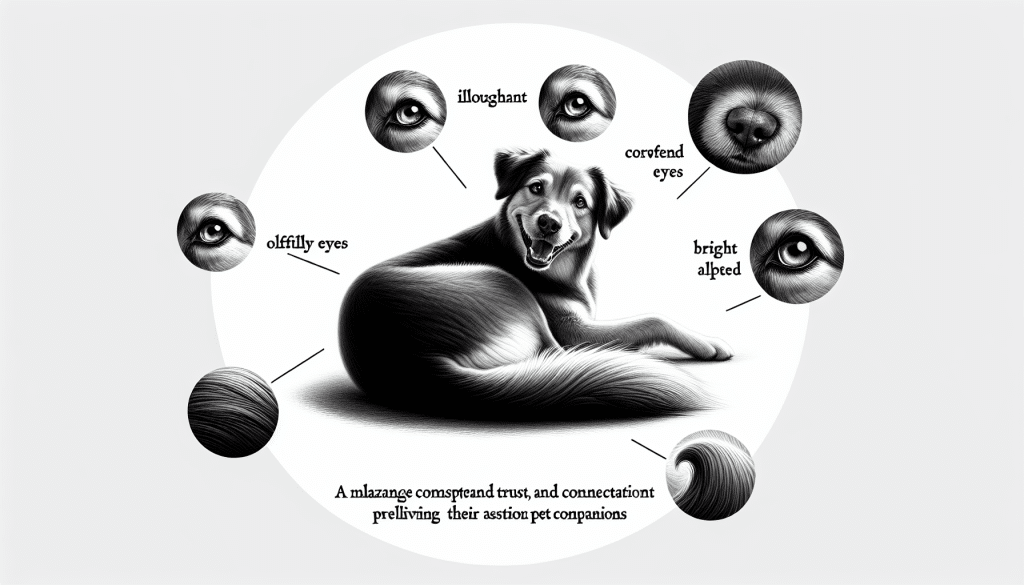Whether you're a proud pet parent or simply a dog lover, being able to understand your furry friend's body language is crucial for building a strong bond and maintaining a harmonious relationship. In this comprehensive guide, you will discover the secrets behind your dog's nonverbal communication, from wagging tails and perked-up ears to subtle signs of anxiety and fear. By learning to interpret your dog's body language, you'll gain a deeper understanding of their emotions, needs, and desires, allowing you to be the best companion possible. So, grab a treat and get ready to embark on an enlightening journey into the world of canine communication.

This image is property of images.unsplash.com.
Understanding Your Dog's Body Language: A Complete Guide
As a dog owner, it is crucial to understand your furry friend's body language. Dogs use various forms of communication to express their emotions, needs, and intentions, and being able to interpret these signals can greatly enhance your bond and prevent misunderstandings. In this comprehensive guide, we will explore the importance of body language in dogs and provide a detailed breakdown of how to interpret different aspects of their non-verbal communication.
Why is Body Language Important in Dogs?
Body language plays a vital role in canine communication as dogs primarily rely on non-verbal signals to express themselves. While they may vocalize through barks, growls, and whines, their body movements and facial expressions provide invaluable insights into their emotional state. By understanding and recognizing these cues, you can effectively communicate with your dog, build trust and bond, and prevent conflicts or misunderstandings.
How to Interpret Tail Movements
A dog's tail can convey a wide range of emotions and intentions. It acts as a prominent indicator of their overall mood and provides important cues for understanding their behavior. Here are some key tail movements to look out for:
Wagging Tail: Happiness and Excitement
A wagging tail typically signifies that your dog is happy and excited. The speed and intensity of the wag can vary, with a rapid and wide wag indicating high levels of enthusiasm, and a slow and gentle wag indicating a more cautious or uncertain state of mind.
Tail Between Legs: Fear or Submission
If your dog tucks their tail between their legs, it is a clear sign of fear or submission. This position is often accompanied by other submissive body language, such as lowered head, cowering posture, or flattened ears. It is important to create a safe and comforting environment for your dog when they exhibit this behavior.
High Tail Wag: Alertness or Aggression
When a dog holds their tail high with a stiff wag, it usually indicates alertness or potential aggression. This is often observed when a dog is on guard or feels threatened. It is important to pay attention to other accompanying signs, such as raised hackles or intense eye contact, to accurately interpret their intentions.
Slow Wag: Insecurity or Uncertainty
A slow wagging tail can indicate insecurity or uncertainty. Your dog may feel unsure about a situation or may be trying to assess the environment before engaging further. It is essential to provide reassurance and a sense of security during such moments.
Puffed Tail: Aggression or Dominance
If your dog puffs out their tail, it is a sign of aggression or dominance. This posture is often seen during confrontations or when a dog is attempting to assert their authority. It is important to address the underlying cause of this behavior and seek professional guidance if needed.
Tucked Tail: Fear or Anxiety
Similar to tail between legs, a tucked tail indicates fear or anxiety. Your dog may be feeling overwhelmed or threatened in their surroundings. It is crucial to create a safe and calm environment, offering support and reassurance to help alleviate their fear or anxiety.
Interpreting Ear Positions
Another vital aspect of understanding your dog's body language is observing their ear positions. Ears can express a range of emotions and provide insights into your dog's overall state of mind. Here are some key ear positions to be aware of:
Erect Ears: Alertness and Interest
When your dog's ears are erect and facing forward, it signifies their attentiveness and curiosity. They are actively engaged with their surroundings and may be exploring or seeking something of interest. This position is typically accompanied by a relaxed facial expression and an overall calm demeanor.
Forward Ears: Friendliness
When your dog's ears are slightly forward, it often indicates friendliness and approachability. This posture is commonly seen when your dog is interacting with familiar people or other animals. It is a positive sign and signifies their willingness to engage and socialize.
Pulled Back Ears: Fear or Submission
If your dog's ears are pulled back tightly against their head, it is a sign of fear or submission. They may be feeling threatened or overwhelmed in a particular situation. It is important to provide a reassuring and secure environment to help them feel more at ease.
Pinned Back Ears: Aggression or Anxiety
Pinning their ears back against their head can indicate aggression or anxiety in dogs. The ears flatten against the head, often accompanied by other signs of aggression such as bared teeth or a growling sound. It is crucial to ensure the safety of all parties involved and seek professional guidance if necessary.
One Ear Forward, One Back: Confusion or Alertness
If your dog's ears are in an asymmetrical position, with one ear forward and the other pulled back, it can suggest confusion or heightened alertness. They may be unsure about a situation or actively trying to process and understand their surroundings.

This image is property of images.unsplash.com.
Understanding Eye Expressions
The eyes are often referred to as the windows to the soul, and this holds true for dogs as well. Their eyes are incredibly expressive and provide valuable insights into their emotional state. Paying attention to your dog's eye expressions can deepen your understanding of their needs and feelings. Here are some common eye expressions to look for:
Relaxed Eyes: Content and Non-threatening
Relaxed and soft eyes indicate that your dog is content and at ease. Their gaze may be calm and unassuming, showcasing a sense of relaxation and comfort. This expression is typically observed during moments of rest or when they feel safe in their environment.
Dilated Pupils: Fear or Aggression
When a dog's pupils are dilated or enlarged, it is often a sign of fear or aggression. This can occur in situations where they feel threatened or are experiencing heightened emotions. Dilated pupils are often accompanied by other signs such as tense body posture or raised hackles.
Narrowed Eyes: Discomfort or Aggression
Narrowing of the eyes can indicate discomfort or aggression in dogs. Squinting or narrowing their eyes often occurs when they are feeling uneasy, stressed, or defensive. This expression can be seen in situations where a dog feels threatened or is engaging in confrontational behavior.
Avoiding Eye Contact: Submission or Fear
If your dog avoids making direct eye contact or averts their gaze, it is a sign of submission or fear. They may be feeling anxious, uncomfortable, or unsure about their current situation. Avoiding eye contact can be seen as a sign of respect or deference to higher-ranking individuals or in unfamiliar environments.
Raised Eyebrows: Attention or Alertness
When your dog raises their eyebrows, it indicates attention and alertness. They may be focusing their attention on something interesting or potential threats in their surroundings. Raised eyebrows are often accompanied by forward ears and an overall engaged body posture.
Decoding Facial Expressions
A dog's facial expressions can provide valuable insights into their emotional state. While they may not have the same range of facial movements as humans, they can still convey a lot of information through their expressions. Here are some key facial expressions to decode:
Relaxed Mouth and Tongue: Calmness
A dog with a relaxed mouth and tongue typically indicates a state of calmness and relaxation. They may have their mouth slightly open, with their tongue visible but not overly tensed or protruding. This expression is often observed during moments of rest or contentment.
Tensed Mouth: Anxiety or Fear
If your dog's mouth appears tense, it can suggest anxiety or fear. They may tightly close their mouth or press their lips together, often accompanied by other signs of distress or discomfort. Paying attention to the context and overall body language can help you better understand the source of their anxiety.
Lip Licking: Stress or Discomfort
Lip licking is a common behavior dogs exhibit when feeling stressed or uncomfortable. It can be seen as a way for them to self-soothe or alleviate tension. If your dog frequently licks their lips in certain situations, it is essential to assess the environment and identify any potential triggers causing their discomfort.
Showing Teeth: Aggression or Warning
When a dog shows their teeth by lifting their lips, it is a clear sign of aggression or warning. This should not be confused with a playful "smile," as it indicates a defensive or threatening stance. If your dog displays this expression, it is essential to take immediate action to ensure the safety of all individuals involved.
Yawning: Stress or Sleepiness
Contrary to popular belief, a dog's yawn is not always a sign of tiredness. In many cases, yawning can indicate stress or discomfort. They may yawn when feeling anxious or during moments of conflict. Understanding the context and accompanying body language can help differentiate between a sleepy yawn and a stress-related one.

This image is property of images.unsplash.com.
The Language of Barks and Growls
While body language is essential in canine communication, vocalizations such as barks and growls also play a significant role. By understanding the different types of vocalizations and their meanings, you can gain deeper insights into what your dog is trying to communicate:
Different Types of Barks and Their Meanings
Dogs have various types of barks, each carrying a distinct message. A high-pitched bark or yelp can indicate excitement, while a deep and loud bark may signify warning or protection. A repetitive bark can indicate frustration or a desire for attention. It is helpful to pay attention to the pitch, duration, and intensity of the bark to decipher its significance.
Growling: Warning or Defensive Behavior
Growling is often a warning signal, indicating that a dog feels threatened or defensive. It can occur in situations where they are protecting their territory, resources, or in response to perceived threats. Growling should always be taken seriously and addressed appropriately to prevent potential conflicts.
Howling: Communication or Anxiety
Howling is a form of vocalization that dogs employ for communication purposes. While it can signify anxiety or distress in some cases, it is also a way for dogs to communicate over long distances or in response to certain stimuli, such as sirens. It is important to consider the context and accompanying body language to understand the meaning behind your dog's howls.
Whining: Attention-Seeking or Discomfort
Whining is a common vocalization that dogs use to seek attention or express discomfort. It can occur when they are hungry, need to go outside, or when they are experiencing physical discomfort. Understanding the context and accompanying body language can help you address your dog's needs effectively.
The Significance of Body Posture
A dog's body posture can reveal a wealth of information about their emotional state and intentions. By paying attention to their overall body posture, you can better understand their needs and ensure their well-being. Here are some significant body postures to interpret:
Relaxed Posture: Contentment
When your dog exhibits a relaxed body posture, it is a clear sign of contentment and relaxation. Their body will appear loose and at ease, with no signs of tension or stiffness. Relaxed posture often accompanies other positive signs such as a wagging tail, soft eyes, and open mouth.
Stiff or Tense Body: Fear or Aggression
If your dog's body appears stiff or tense, it usually indicates fear or aggression. They may be preparing for a fight-or-flight response and may exhibit other signs of distress, such as raised hackles or a lowered head. It is crucial to assess the situation and provide appropriate support to prevent escalation.
Cowering: Extreme Fear or Submission
Cowering is a strong indication of extreme fear or submission in dogs. They may lower their body close to the ground, with their tail tucked between their legs and their ears pinned back. It is essential to create a safe and comforting environment for your dog when they exhibit this posture, as they may be experiencing intense distress.
Raised Hackles: Aggression, Fear, or Excitement
Raised hackles refer to the hair along a dog's back and neck standing on end. While it is commonly associated with aggression, it can also be a sign of fear or excitement. It is crucial to observe other accompanying body language and the context to accurately interpret your dog's emotional state.
Rolling Over: Submission or Playfulness
When a dog rolls over onto their back, it signifies submission or playfulness. If they expose their belly and allow you to pet them, it indicates trust and submissiveness. However, it is important to note that rolling over can also be an involuntary response to fear or discomfort in some cases.
Puffed Out Chest: Dominance or Confidence
A puffed out chest often indicates dominance or confidence in dogs. It is accompanied by an upright stance and often occurs in situations where a dog is trying to assert their authority or establish their position within a social hierarchy. Addressing the underlying cause of this behavior and seeking professional guidance, if necessary, is crucial to maintaining a harmonious relationship.

Interpreting Paw Movements
Paw movements can serve as subtle indicators of your dog's emotions and needs. While they may not be as prominent as tail wagging or ear positions, observing your dog's paw movements can provide additional insights into their overall body language. Here are some common paw movements to interpret:
Paw Lifting: Alertness or Curiosity
When your dog lifts their paw slightly off the ground, it signals alertness and curiosity. They may be trying to get a better view or assess a particular situation. Paw lifting often occurs when dogs encounter unfamiliar scents, sounds, or objects.
Pawing: Attention-Seeking or Anxious Behavior
If your dog paws at you or an object, it can indicate attention-seeking behavior or anxiety. They may be trying to get your attention, communicate a need, or express discomfort. Understanding the context and other accompanying signs of anxiety can help address their underlying needs effectively.
Digging: Boredom or Anxiety
Dogs may engage in digging behavior when they are bored or anxious. It can be a way to release pent-up energy or alleviate stress. Providing mental and physical stimulation can help redirect this behavior and prevent destructive digging.
Trembling Paws: Fear or Nervousness
Trembling or shaking paws can indicate fear or nervousness in dogs. This behavior is often accompanied by other signs of anxiety, such as cowering or avoiding eye contact. Identifying the source of their fear and providing a safe and comforting environment is essential to help alleviate their distress.
Understanding Vocalization
Vocalization is an important aspect of canine communication. While we have covered barks, growls, howls, and whines in the previous sections, it is essential to understand that each dog has their unique vocalization patterns. By paying attention to your dog's vocalizations and assessing the context in which they occur, you can gain a deeper understanding of their needs, desires, and emotions. Remember to consider the pitch, duration, and intensity of their vocalizations to accurately interpret their meanings.

Recognizing Signs of Fear and Anxiety
Fear and anxiety are common emotions experienced by dogs and can significantly impact their behavior and well-being. It is crucial for dog owners to recognize the signs of fear and anxiety to provide the necessary support and reassurance. Some common signs include:
- Tail tucked between legs
- Pinned back ears
- Avoiding eye contact
- Cowering or flattening of the body
- Trembling or shaking
- Excessive panting or drooling
- Excessive yawning or lip licking
- Hiding or seeking escape routes
If you notice any of these signs in your dog, it is important to create a safe and calm environment, offer reassurance, and address any potential triggers causing their fear or anxiety. Seeking professional help from a certified dog trainer or animal behaviorist may also be beneficial in managing and resolving these issues.
Understanding Aggression Signals
Aggression is a complex behavior that can arise from various underlying factors such as fear, resource guarding, or territoriality. It is important for dog owners to recognize and understand the early signs of aggression to prevent potentially dangerous situations. Some common aggression signals include:
- Growling or snarling
- Showing teeth
- Lunging or snapping
- Stiff or frozen body posture
- Raised hackles
- Intense and prolonged direct eye contact
If you observe any of these signs, it is crucial to assess the situation and ensure the safety of all individuals involved. Seeking professional help from a qualified dog behavior expert is highly recommended to address aggression issues safely and effectively.
The Role of Body Language in Communication
Body language is an integral part of canine communication. Dogs rely heavily on non-verbal cues to express their emotions, needs, and intentions. By understanding and interpreting their body language, you can effectively communicate with your dog, strengthen your bond, and prevent conflicts or misunderstandings. Paying attention to their tail movements, ear positions, eye expressions, facial expressions, vocalizations, body posture, paw movements, and overall demeanor allows you to gain a comprehensive understanding of their emotional state and address their needs accordingly.
Tips for Communicating with Your Dog
While body language is a crucial aspect of canine communication, there are several additional tips for effectively communicating with your dog:
Observe and Learn Your Dog's Unique Signals
Every dog has their unique set of body language cues and vocalizations. Take the time to observe and learn your dog's specific signals, as this will deepen your understanding of their needs and emotions. Building this knowledge will enhance your ability to communicate effectively and strengthen your bond.
Respect Your Dog's Personal Space
Just like humans, dogs also have preferences when it comes to personal space. Respect their boundaries and allow them to approach or retreat as they feel comfortable. Forcing interactions or invading their personal space can lead to anxiety or aggression.
Use Positive Reinforcement
Positive reinforcement is a powerful tool for training and communication. Rewarding desired behaviors with treats, praise, or play encourages your dog to repeat those behaviors. It helps establish a positive association between certain actions and positive outcomes, making communication more effective and enjoyable.
Avoid Punishment-Based Training
Punishment-based training methods can lead to fear, anxiety, and aggression in dogs. Instead, focus on positive reinforcement, patience, and consistency. Rewarding good behavior and redirecting unwanted behaviors into more appropriate outlets allows for a stronger and more trusting relationship.
Seek Professional Help if Needed
If you encounter challenges in understanding or communicating with your dog, do not hesitate to seek professional help. Certified dog trainers or animal behaviorists can assess your dog's behavior, provide tailored guidance, and help address specific issues effectively.
Understanding your dog's body language is a continuous learning process. By investing time and effort into deciphering their non-verbal cues, you can develop a deeper bond, ensure their well-being, and create a harmonious and fulfilling relationship. Remember to be patient, observant, and responsive to their needs and emotions, and enjoy the journey of discovering the unique language of your beloved canine companion.


